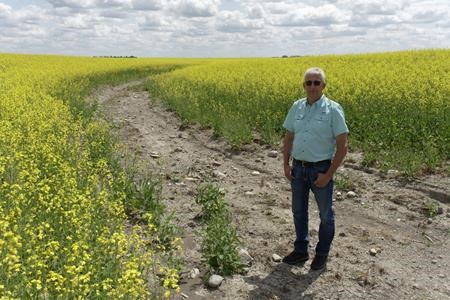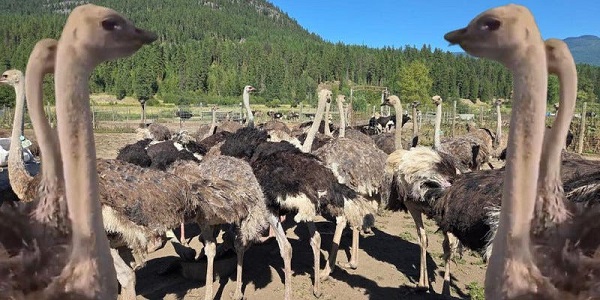Alberta
‘Not as dramatic’: Saskatchewan farmers draining water demonstrate benefits

GRENFELL, Sask. — It’s an area of farmland Ryan Maurer says is worth as much as a Lamborghini.
High run-off flooded one of his fields in spring 2022, leaving shallow pools of water. This was before the farmer opened ditches to drain it.
“Would you take your Lamborghini and park it in a slough?” Maurer asked on his farm near Grenfell, Sask., about 125 kilometres east of Regina.
No, he says, he wouldn’t.
“But society’s asking us to do that,” Maurer added. “And then they turn around and tell us to grow more food.”
Maurer’s land is part of a drainage network known as the Tetlock Conservation and Development Area Authority. It’s where farmers work together to move water through each other’s land and out into a creek.
The farmers in the Tetlock network say the water is moved in a managed and slower pace when it’s released, helping mitigate potential flooding downstream. There are control gates, smaller culverts, tile piping and holding ponds.
In fact, the Tetlock normally only adds 0.5 per cent of water to the flow of the creek, indicates data provided by the farmers who oversee the network.
“It’s not as dramatic as everybody says it is,” said Owen Pekrul, a farmer who’s also part of the drainage network. “Because it’s a ditch or it’s organized, they think it affects a lot of things.”
But for some, drainage is a problem.
Farmers downstream of some other networks say huge gushes of water continue to wash out their fields each year.
Environmental groups also worry about the loss of wetlands, as some are drained to make way for more arable acres. They say this puts habitats at risk and causes water quality to degrade.
Rural municipalities have raised concerns about illegal works causing water to breach grid roads.
Rural officials have asked the Water Security Agency, which is in charge of overseeing drainage, to ensure illegal drainers get permits.
“The biggest concern that we have is that many ratepayers just are not following the rules that are in place, the laws if you will,” said Helen Meekins, a councillor with the Rural Municipality of Pleasantdale in southeast Saskatchewan.
“The rural municipality isn’t against drainage,” Meekins added. “But, if they go through the permit process, then at least we know where there’s going to be more water and how it’s going to affect the infrastructure that we have in place.”
Some farmers say managed networks, such as the Tetlock, could help address flooding issues as long as everyone upstream and downstream can work together.
Maurer, as well as others involved in the network, are members of the Saskatchewan Farm Stewardship Association, a group that has lobbied the province for managed drainage to promote soil health and crop production.
He said drainage helps him turn soil that’s too salty into something that can grow healthy crops.
It also allows him to be more productive with his time on the field. That’s because those working the machines don’t have to move around various sloughs when they apply fertilizer and spray chemicals.
“These little sloughs are a couple inches of water. There’s nothing major,” Maurer said. “So, we over-apply. How do we get around that? Well, drainage and management is the answer.”
Not all drainage has been done in a managed way in Saskatchewan.
For decades, producers have dug ditches to move water out without approval from the Water Security Agency.
In 2018, Saskatchewan’s auditor estimated there were up to 9,712 square kilometres of land with unapproved works.
The agency has said it’s brought many unpermitted works into compliance by working with landowners and making sure the stream, pond or lake can handle the amount of water flowing in.
Research projects have also been looking into best practices. In one, a farmer has been draining water from various sloughs into one larger consolidation pond.
Candace Mitschke, the executive director with the Saskatchewan Farm Stewardship Association, said different solutions are required for each farm because landscapes across the province aren’t the same.
But, she said, issues can be resolved when people work together.
In rare cases, farmers have expropriated downstream land so they can get a permit and manage the water appropriately.
“Sometimes you’re not going to get people to co-operate no matter what you do. In those cases, that’s when expropriation is that important piece and enables that network to function,” Mitschke said.
The Water Security Agency still has a ways to go to bring all unapproved works into compliance.
Since 2017, only about a third of land with unpermitted works, about 3,146 square kilometres, has been brought into compliance.
Saskatchewan’s auditor has recommended unpermitted drainage be addressed quickly. The longer people wait, it noted, the more frustrated they become.
The auditor has also recommended the agency establish a wetlands policy to ensure water quality doesn’t degrade, which the agency says it’s working on.
For Maurer, it’s all about water management. He again pointed to the Tetlock network as an example of good practices.
“If everybody did that, it would be managed going in,” he said. “Just by saying, ‘Quit draining water,’ it doesn’t help anybody. It creates the problem.”
This report by The Canadian Press was first published July 22, 2023.
Jeremy Simes, The Canadian Press
Alberta
Federal budget: It’s not easy being green

From Resource Works
Canada’s climate rethink signals shift from green idealism to pragmatic prosperity.
Bill Gates raised some eyebrows last week – and probably the blood pressure of climate activists – when he published a memo calling for a “strategic pivot” on climate change.
In his memo, the Microsoft founder, whose philanthropy and impact investments have focused heavily on fighting climate change, argues that, while global warming is still a long-term threat to humanity, it’s not the only one.
There are other, more urgent challenges, like poverty and disease, that also need attention, he argues, and that the solution to climate change is technology and innovation, not unaffordable and unachievable near-term net zero policies.
“Unfortunately, the doomsday outlook is causing much of the climate community to focus too much on near-term emissions goals, and it’s diverting resources from the most effective things we should be doing to improve life in a warming world,” he writes.
Gates’ memo is timely, given that world leaders are currently gathered in Brazil for the COP30 climate summit. Canada may not be the only country reconsidering things like energy policy and near-term net zero targets, if only because they are unrealistic and unaffordable.
It could give some cover for Canadian COP30 delegates, who will be at Brazil summit at a time when Prime Minister Mark Carney is renegotiating his predecessor’s platinum climate action plan for a silver one – a plan that contains fewer carbon taxes and more fossil fuels.
It is telling that Carney is not at COP30 this week, but rather holding a summit with Alberta Premier Danielle Smith.
The federal budget handed down last week contains kernels of the Carney government’s new Climate Competitiveness Strategy. It places greater emphasis on industrial strategy, investment, energy and resource development, including critical minerals mining and LNG.
Despite his Davos credentials, Carney is clearly alive to the fact it’s a different ballgame now. Canada cannot afford a hyper-focus on net zero and the green economy. It’s going to need some high octane fuel – oil, natural gas and mining – to prime Canada’s stuttering economic engine.
The prosperity promised from the green economy has not quite lived up to its billing, as a recent Fraser Institute study reveals.
Spending and tax incentives totaling $150 billion over a decade by Ottawa, B.C, Ontario, Alberta and Quebec created a meagre 68,000 jobs, the report found.
“It’s simply not big enough to make a huge difference to the overall performance of the economy,” said Jock Finlayson, chief economist for the Independent Contractors and Business Association and co-author of the report.
“If they want to turn around what I would describe as a moribund Canadian economy…they’re not going to be successful if they focus on these clean, green industries because they’re just not big enough.”
There are tentative moves in the federal budget and Climate Competitiveness Strategy to recalibrate Canada’s climate action policies, though the strategy is still very much in draft form.
Carney’s budget acknowledges that the world has changed, thanks to deglobalization and trade strife with the U.S.
“Industrial policy, once seen as secondary to market forces, is returning to the forefront,” the budget states.
Last week’s budget signals a shift from regulations towards more investment-based measures.
These measures aim to “catalyse” $500 billion in investment over five years through “strengthened industrial carbon pricing, a streamlined regulatory environment and aggressive tax incentives.”
There is, as-yet, no commitment to improve the investment landscape for Alberta’s oil industry with the three reforms that Alberta has called for: scrapping Bill C-69, a looming oil and gas emissions cap and a West Coast oil tanker moratorium, which is needed if Alberta is to get a new oil pipeline to the West Coast.
“I do think, if the Carney government is serious about Canada’s role, potentially, as an global energy superpower, and trying to increase our exports of all types of energy to offshore markets, they’re going to have to revisit those three policy files,” Finlayson said.
Heather Exner-Pirot, director of energy, natural resources and environment at the Macdonald-Laurier Institute, said she thinks the emissions cap at least will be scrapped.
“The markets don’t lie,” she said, pointing to a post-budget boost to major Canadian energy stocks. “The energy index got a boost. The markets liked it. I don’t think the markets think there is going to be an emissions cap.”
Some key measures in the budget for unlocking investments in energy, mining and decarbonization include:
- incentives to leverage $1 trillion in investment over the next five years in nuclear and wind power, energy storage and grid infrastructure;
- an expansion of critical minerals eligible for a 30% clean technology manufacturing investment tax credit;
- $2 billion over five years to accelerate critical mineral production;
- tax credits for turquoise hydrogen (i.e. hydrogen made from natural gas through methane pyrolysis); and
- an extension of an investment tax credit for carbon capture utilization and storage through to 2035.
As for carbon taxes, the budget promises “strengthened industrial carbon pricing.”
This might suggest the government’s plan is to simply simply shift the burden for carbon pricing from the consumer entirely onto industry. If that’s the case, it could put Canadian resource industries at a disadvantage.
“How do we keep pushing up the carbon price — which means the price of energy — for these industries at a time when the United States has no carbon pricing at all?” Finlayson wonders.
Overall, Carney does seem to be moving in the right direction in terms of realigning Canada’s energy and climate policies.
“I think this version of a Liberal government is going to be more focused on investment and competitiveness and less focused around the virtue-signaling on climate change, even though Carney personally has a reputation as somebody who cares a lot about climate change,” Finlayson said.
“It’s an awkward dance for them. I think they are trying to set out a different direction relative to the Trudeau years, but they’re still trying to hold on to the Trudeau climate narrative.”
Pictured is Mark Carney at COP26 as UN Special Envoy on Climate Action and Finance. He is not at COP30 this week. UNRIC/Miranda Alexander-Webber
Resource Works News
Alberta
ChatGPT may explain why gap between report card grades and standardized test scores is getting bigger

From the Fraser Institute
By Paige MacPherson and Max Shang
In Alberta, the gap between report card grades and test/exam scores increased sharply in 2022—the same year ChatGPT came out.
Report card grades and standardized test scores should rise and fall together, since they measure the same group of students on the same subjects. But in Alberta high schools, report card grades are rising while scores on Provincial Achievement Tests (PAT) and diploma exams are not.
Which raises the obvious question—why?
Report card grades partly reflect student performance in take-home assignments. Standardized tests and diploma exams, however, quiz students on their knowledge and skills in a supervised environment. In Alberta, the gap between report card grades and test/exam scores increased sharply in 2022—the same year ChatGPT came out. And polling shows Canadian students now rely heavily on ChatGPT (and other AI platforms).
Here’s what the data show.
In Alberta, between 2016 and 2019 (the latest year of available comparable data), the average standardized test score covering math, science, social study, biology, chemistry, physics, English and French language arts was just 64, while the report card grade 73.3—or 14.5 per cent higher. Data for 2020 and 2021 are unavailable due to COVID-19 school closures, but between 2022 and 2024, the gap widened to 20 per cent. This trend holds regardless of school type, course or whether the student was male or female. Across the board, since 2022, students in Alberta high schools are performing significantly better in report card grades than on standardized tests.
Which takes us back to AI. According to a recent KPMG poll, 73 per cent of students in Canada (high school, vocational school, college and university) said they use generative AI in their schoolwork, an increase from the previous year. And 71 per cent say their grades improved after using generative AI.
If AI is simply used to aid student research, that’s one thing. But more than two-thirds (66 per cent) of those using generative AI said that although their grades increased, they don’t think they’re learning or retaining as much knowledge. Another 48 per cent say their “critical thinking” skills have deteriorated since they started using AI.
Acquiring knowledge is the foundation of higher-order thinking and critical analysis. We’re doing students a deep disservice if we don’t ensure they expand their knowledge while in school. And if teachers award grades, which are essentially inflated by AI usage at home, they set students up for failure. It’s the academic equivalent of a ski coach looking at a beginner and saying, “You’re ready for the black diamond run.” That coach would be fired. Awarding AI-inflated grades is not fair to students who will later struggle in college, the workplace or life beyond school.
Finally, the increasing popularity of AI underscores the importance of standardized testing and diploma exams. And parents knew this even before the AI wave. A 2022 Leger poll found 95 per cent of Canadian parents with kids in K-12 schools believe it’s important to know their child’s academic performance in the core subjects by a fair and objective measure. Further, 84 per cent of parents support standardized testing, specifically, to understand how their children are doing in reading, writing and mathematics. Alberta is one of the only provinces to administer standardized testing and diploma exams every year.
Clearly, parents should oppose any attempt to reduce accountability and objective testing in Alberta schools.
-

 COVID-192 days ago
COVID-192 days agoMajor new studies link COVID shots to kidney disease, respiratory problems
-

 Addictions24 hours ago
Addictions24 hours agoCanadian gov’t not stopping drug injection sites from being set up near schools, daycares
-

 International2 days ago
International2 days agoIs America drifting toward civil war? Joe Rogan thinks so
-

 Business23 hours ago
Business23 hours agoParliamentary Budget Officer begs Carney to cut back on spending
-

 International2 days ago
International2 days agoBondi and Patel deliver explosive “Clinton Corruption Files” to Congress
-

 International2 days ago
International2 days agoState Department designates European Antifa groups foreign terror organizations
-

 International2 days ago
International2 days agoUS announces Operation Southern Spear, targeting narco-terrorists
-

 Censorship Industrial Complex2 days ago
Censorship Industrial Complex2 days agoEU’s “Democracy Shield” Centralizes Control Over Online Speech











